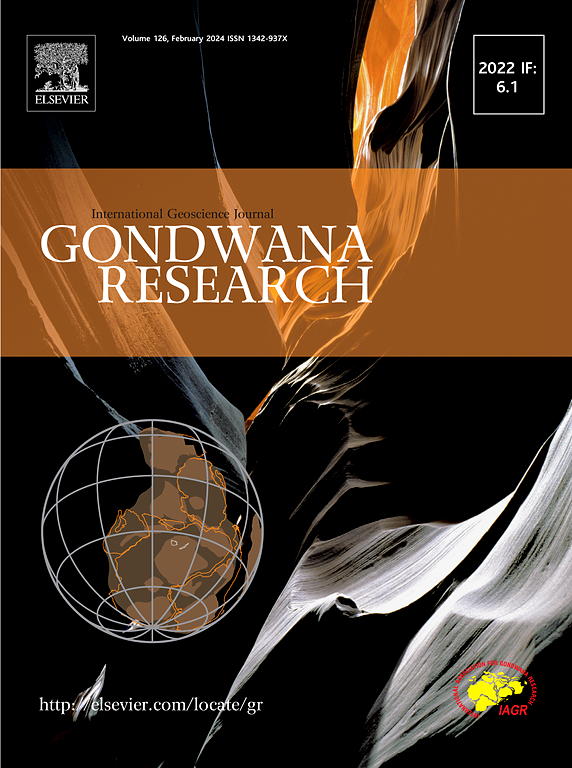婆罗洲中部的古元古代变质基底:连接印度支那和哥伦比亚的劳伦西亚
IF 7.2
1区 地球科学
Q1 GEOSCIENCES, MULTIDISCIPLINARY
引用次数: 0
摘要
结合东南亚恩布依杂岩及其伴生块状花岗岩变质岩的全岩地球化学和Sr-Nd-Pb同位素结果,锆石U-Pb年代学和Lu-Hf同位素数据记录了该地区的前寒武纪构造演化,并约束了其与哥伦比亚超大陆Laurentia的关系。Embuoi杂岩的斜长石角闪岩、正长岩和副长岩的锆石U-Pb年龄在1898-1820 Ma之间,是婆罗洲已知最古老的岩石。Embuoi斜长石角闪岩具有弧状地球化学特征,εNd(t) = +2.4 ~ +6.7, (206Pb/204Pb)i = 18.75 ~ 19.11, (207Pb/204Pb)i = 15.65 ~ 15.75, (208Pb/204Pb)i = 38.51 ~ 39.31,表明其来源为类似morb的源,受俯冲相关成分输入的影响。正长岩与A2花岗岩有亲缘关系,起源于碰撞后的新太古代-古元古代地壳深熔作用。约1.85 Ga副长岩的锆石εHf(t)和THfDM值相近,Sr-Nd-Pb同位素与同时期正长岩一致,表明其近端来源于古元古代长英岩。该杂岩在太古宙地壳基础上记录了古元古代恩布伊造山运动的发育。将东南亚邻近块体的现有数据与Laurentia块体的数据进行综合,表明恩布伊块体与印度支那块体的构造亲缘性,将它们定位为哥伦比亚超大陆内西南Laurentia的西部延伸。古元古代的Embuoi造山作用被三叠纪(259 ~ 201 Ma)变质作用覆盖,并被三叠纪(233 ~ 211 Ma)大块花岗岩侵入,这些花岗岩与东亚活动大陆边缘的古太平洋俯冲有关。这些发现确立了婆罗洲前寒武纪基底构造,强调了其在哥伦比亚组合和三叠纪古太平洋活动边缘动力学中的重要意义。本文章由计算机程序翻译,如有差异,请以英文原文为准。

Paleoproterozoic metamorphic basement in Central Borneo: linking Indochina and Laurentia in Columbia
Zircon U-Pb geochronological and Lu-Hf isotopic data, combined with whole-rock geochemical and Sr-Nd-Pb isotopic results for metamorphic rocks from the Embuoi Complex and associated massive granites, SE Asia, document the Precambrian tectonic evolution of this region and constrain its relationship to Laurentia in the Columbia supercontinent. Plagioclase amphibolite, orthogneiss and paragneiss from the Embuoi Complex yield zircon U-Pb ages in the range of 1898–1820 Ma, representing the oldest known rocks in Borneo. The Embuoi plagioclase amphibolite exhibits the arc-like geochemical signatures with εNd(t) = +2.4–+6.7, (206Pb/204Pb)i = 18.75–19.11, (207Pb/204Pb)i = 15.65–15.75 and (208Pb/204Pb)i = 38.51–39.31, suggesting the derivation from a MORB-like source modified by input of the subduction-related components. Orthogneisses have affinity to A2 granite and originated by Neoarchean–Paleoproterozoic crustal anatexis in a post-collisional setting. The ca. 1.85 Ga paragneiss shares comparable zircon εHf(t) and THfDM values and consistent Sr-Nd-Pb isotopes with the coeval orthogneiss, suggesting proximal derivation from a Paleoproterozoic felsic source. Rocks of the complex record development of a Paleoproterozoic Embuoi orogeny on the foundation of Archaean crust. Integration of available data from the adjacent blocks in SE Asia with those from Laurentia suggests the tectonic affinity of the Embuoi fragment with the Indochina block, positioning them both as the western extension of SW Laurentia within the Columbia supercontinent. The Paleoproterozoic Embuoi orogeny was overprinted by Triassic (259–201 Ma) metamorphism and intruded by Triassic (233–211 Ma) massive granites that correlate with Paleo-Pacific subduction along the East Asia active continental margin. These findings establish the Precambrian basement architecture of Borneo and underscore its significance in Columbia’s assembly and Triassic Paleo-Pacific active margin dynamics.
求助全文
通过发布文献求助,成功后即可免费获取论文全文。
去求助
来源期刊

Gondwana Research
地学-地球科学综合
CiteScore
12.90
自引率
6.60%
发文量
298
审稿时长
65 days
期刊介绍:
Gondwana Research (GR) is an International Journal aimed to promote high quality research publications on all topics related to solid Earth, particularly with reference to the origin and evolution of continents, continental assemblies and their resources. GR is an "all earth science" journal with no restrictions on geological time, terrane or theme and covers a wide spectrum of topics in geosciences such as geology, geomorphology, palaeontology, structure, petrology, geochemistry, stable isotopes, geochronology, economic geology, exploration geology, engineering geology, geophysics, and environmental geology among other themes, and provides an appropriate forum to integrate studies from different disciplines and different terrains. In addition to regular articles and thematic issues, the journal invites high profile state-of-the-art reviews on thrust area topics for its column, ''GR FOCUS''. Focus articles include short biographies and photographs of the authors. Short articles (within ten printed pages) for rapid publication reporting important discoveries or innovative models of global interest will be considered under the category ''GR LETTERS''.
 求助内容:
求助内容: 应助结果提醒方式:
应助结果提醒方式:


